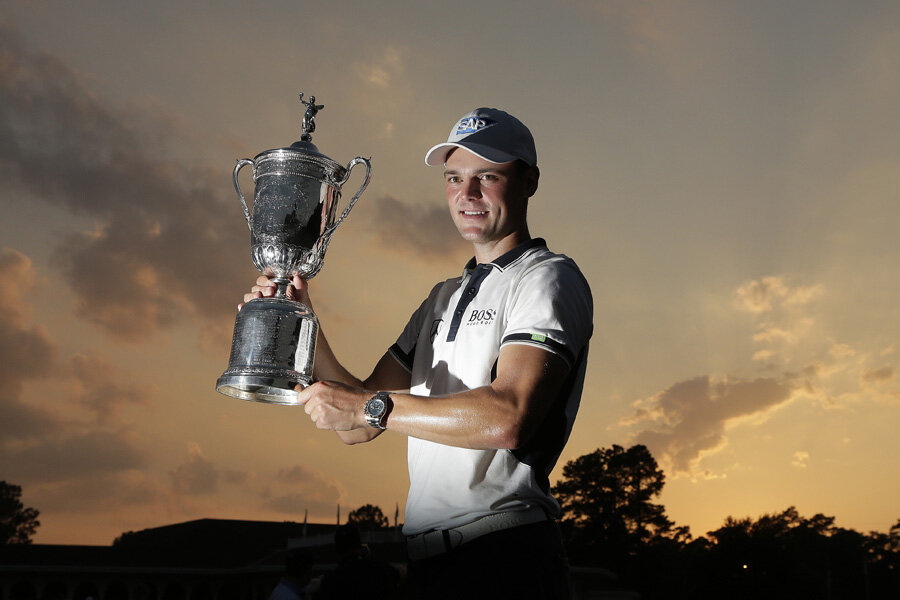Martin Kaymer becomes first German to win US Open golf title
Loading...
| Pinehurst, N.C.
They could've given Martin Kaymer the trophy before the weekend the way he ripped through Pinehurst No. 2 like he was playing the local muni.
Certainly, they could've had the ceremony on Saturday, after he shook off five bogeys to maintain a commanding lead at the US Open.
By the time the USGA got around to handing Kaymer his hardware in the fading sunlight Sunday evening, this felt like a coronation that had been delayed far too long.
That's how dominant Kaymer was.
He played his own event.
Everyone else was in the second flight.
With a performance reminiscent of Rory McIlroy's domination at Congressional and Tiger Woods' romp around Pebble Beach, Kaymer blew away the field in the sandhills of North Carolina, on a course that was as tough as advertised — for everyone except the 29-year-old German.
Kaymer closed out his eight-stroke victory with a 1-under 69, the only player in the final eight groups to break par. He finished at 9-under 271 overall; only two other guys managed to get into the red, Erik Compton and Rickie Fowler, tied for second but nowhere close to winning.
"I knew we were playing for second," said Compton, a two-time, heart-transplant recipient who drew some of the loudest cheers of the week.
Compton was inspiring.
Kaymer was dominant.
With a win last month at The Players Championship — a de facto major — and his rout at Pinehurst, Kaymer has resoundingly reclaimed his place as one of the game's top players.
He was in that spot not so long ago after winning the 2010 PGA Championship at Whistling Straits and moving up to No. 1 in the world rankings early the next year. Despite his success, he felt something in his game was missing, the sort of all-around repertoire he would need to stay on top. He had always been successful with the fade, working the ball from left to right, but knew he needed a draw to round things out.
The change was a slow, tedious process, resulting in a winless streak that stretched over 29 tournaments and 18 months.
Now able to work the ball in both directions, he was back on top at Sawgrass.
Then he made a mockery of Pinehurst.
"You want to win majors in your career, but if you can win one more, it means so much more," Kaymer said. "When I went through that low, they called me the one-hit wonder and those things. ... It's quite satisfying to have two under your belt."
Kaymer opened with back-to-back 65s, his 10-under score the lowest ever at the Open through 36 holes. He struggled a bit in the third round, settling for a 72 in much tougher conditions, but that was good enough to take a five-stroke lead to the closing round.
The finale was nothing more than a formality.
"He kind of killed the event in the first two days," said Henrik Stenson, among those who tied for fourth at 281. "He went out and shot two 65s and left everyone in the dust."
Where does Kaymer go from here?
He's already joined a pretty select club. Over the last three decades, only Woods, McIlroy, Seve Ballesteros and Ernie Els have won two majors and been ranked No. 1 before their 30th birthday.
Not that Kaymer intends to stop here.
"I'm only 29 years old," he said. "I hope to have another few years ahead of me."
With Woods' future in doubt after back surgery that kept him out of the Open, there's a new wave of young golfers hoping to carve out their place in the game. Fowler, who played in the final group at a major for the first time, is only 25. So is McIlroy, a two-time major champion who failed to challenge at Pinehurst. Twenty-year-old Jordan Spieth faded on the weekend, but had another solid performance in a major championship. Certainly his best days are ahead of him.
After a couple of years under the radar, Kaymer is part of the conversation again.
This is what he had in mind all along, even when he was struggling.
"I was really looking forward to competing against them and to see who has the stronger and better nerves coming down the last five, six holes in big tournaments," Kaymer said. "So that is what everybody can look forward to."
Compton has plenty to look forward to after the best performance of his career.
Until now, he was known mainly as the guy who had his first transplant at age 12 and another when he was 28 after a near-fatal heart attack.
Six years removed from that traumatic event, Compton transformed himself to, in the words of his mother, "a golfer with two transplants, not a transplant recipient who plays golf."
"I go from where I was a few years ago, and now I'm able to play in major championships," said Compton, who choked back tears. "I showed the world today that I'm capable of playing good golf under extreme pressure and heat.
"And," he added, "I think I showed myself."
For Compton, finishing in a tie for second felt as good as a victory, especially when he pulled off a remarkable shot out of a bunker at the 18th to salvage par. The ovation he received was as loud as the one Kaymer would receive a few minutes later in the final group.
Actually, that was appropriate.
This US Open was actually two tournaments.
Kaymer played his alone.





